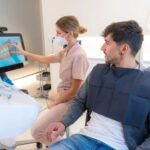Virtual Reality is an emerging technology designed to immerse somebody in a digitally simulated environment. Giving a simulation of a real-world system, VR provides experiences in ways that are interactive and visually gripping.
The manufacturing process of products – design, development, and testing are being revolutionized by this technology. In view of the same, and since all industries have a need to become more efficient and innovative with time, VR is fast setting in and taking over as very crucial.
Understanding Virtual Reality
Virtual Reality is a computer-simulated environment in which the user is given the feeling of actually being in the environment and capable of interacting with it. VR is driven through specialized hardware and software that engages the users fully.
Basics of VR Technology
VR technology is an artificial computer-simulated world that the user can access as he/she would in real life. This is through the coupling of visual, audio, and physical fittings. Some of these gadgets include:
- VR Headsets: These are very central when it comes to the whole experience of VR. It helps the user gain a 360 degrees field of view, which is set in a manner that would be adjustable to his head rotating. Other examples include the Oculus Rift and the HTC Vive.
- Software: The software that is implementing VR applications, such as games, is designed to generate and manage the virtual environment. The software is producing the graphics and sound – letting the user get into the computer-generated world – the media that Techopedia defines is called the artificial reality.
- Haptic Devices: The devices will add more effect on the experience for the users in VR due to the kinesthetic experience. The haptic gloves, suits are going to help in generating the feel of the surface or any virtual object.
Current Use Cases
VR is changing manufacturing and other industries with rising new design methods, training, and simulation.
1. Design
In manufacturing, VR provides the ability for engineers and designing personnel to visualize a 3D model of a product before being produced. With the integration of 3D product visualization technology, it becomes easier to examine detailed representations of a product, allowing for more accurate identification of design flaws in the early stages. In this way, hence making it easier for uncovering the design flaws in the earlier stage, the development process also becomes more precise.
2. Training
VR training can be applied to train workforces on how to use complex machineries and procedures. In this manner, it reduces the probability of accidents and increases the assimilation of knowledge by experiential practice of complex working systems without real-world ramifications.
3. Simulations
VR-based simulations emulating physical environments are effective in streamlining and optimizing manufacturing processes. It helps them iron out the nitty-gritty of the procedure at almost all ends for increased efficiency.
Applications of VR in Manufacturing
Virtual Reality (VR) is revolutionizing the manufacturing industry with its innovative application to drive the process to be more and more accurate and efficient. Be it for injection molding manufacturers optimization, VR technology offers brand new ways to face today’s problems and new methods of solution formulation.
Mold Design
VR is a way by which prototypes are developed, tested, and modified in mold design. This can be achieved by creating or altering virtual prototypes where designers can visualize complex concepts in detail.
Virtual injection mold design for instance, can be visualized and changed at any time through VR. This can make changes fast and iterative, course-correcting the designs, thus making them accurate and optimal. Virtual prototypes at the design stage find out possible defects in them, hence reducing the need for physical changes and saving both time and resources.
Mold Manufacturing
There is a center-stage contribution from VR at the mold manufacturing phase for training and process optimization. VR provides a risk-free environment for training both operators and technicians.
The moment computers load up the virtual environment, the trainee can start looking out for the running of complex machines and engagement in sophisticated works. This technology helps the trainees gain knowledge and skills on how to operate complex machines and handle sophisticated tasks without any real-world hazards.
On the other hand, virtual reality technology allows for such virtual walks through manufacturing setups that enable the teams to find inconsistencies before the real manufacturing process starts. Such virtual inspections facilitate the workflow process by pinning down work areas of inefficiency to increase operational effectiveness through making the adjustments.
Benefits of VR in Manufacturing
Virtual Reality (VR) brings numerous advantages to the manufacturing sector, enhancing various aspects from design to training. By integrating VR into manufacturing processes, companies can experience significant improvements through:
- Improved design accuracy
- Enhanced collaboration
- Cost and time efficiency
- Training and skill development
1. Improved Accuracy of Design
Virtual reality allows designing in manufacturing to be more accurate. This can be achieved by providing a platform where developers can interact with 3D models in an immersive environment.
It helps in the identification and correction of design flaws early in the process, thus avoiding the necessity for multiple physical prototypes. Companies cut down on material costs and fasten the design process, limiting the time taken for iterative testing and reengineering.
2. Enhanced Collaboration
VR allows various individuals from different places to pool together in a virtual environment. The interaction is real time, and each makes a decision based on such circumstances.
There is no geographical separation, and communication systems are based on viewing and manipulating the same virtual objects. Better communication and cooperation lead to sound decision-making within a design and production process, thus raising the overall effectiveness of a processing manufacturing.
3. Cost and Time Efficiency
There are certain cost and time-saving benefits from integrating VR into the manufacturing processes. Reduction of development cycles will be achieved through rapid testing and redesign integration.
Besides, due to the fact that VR offers the potential for simulating production procedures, problems can be found before they usually appear, and material waste and expensive rework can be eliminated. Companies can be more cost-effective and reduce production delays if they work out problems before physical production commences.
4. Training and Skill Development
Through the use of VR, companies in the manufacturing sector can improve their workers through training and skill development. This offers a safe and highly immersive environment within which employees can learn and train themselves to perform complex tasks without necessarily performing them.
The hands-on practice readies the workers for scenarios involved in actual production, with a reduction in general work errors and improvement in safety. The means through which the training is delivered in a VR environment assures that workers are highly prepared to respond effectively to the demands of modern manufacturing processes.










